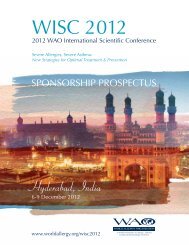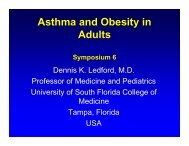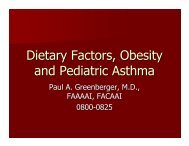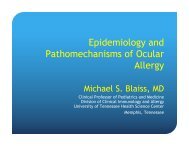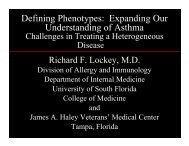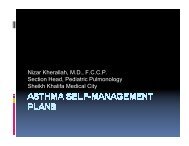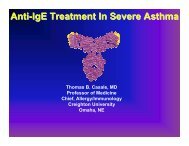Dubai Final-v20.indd - World Allergy Organization
Dubai Final-v20.indd - World Allergy Organization
Dubai Final-v20.indd - World Allergy Organization
You also want an ePaper? Increase the reach of your titles
YUMPU automatically turns print PDFs into web optimized ePapers that Google loves.
ABstrACts<br />
Conclusion:sPlAD and FPigs, both rare forms of allergic diseases, coexisted in 5 infants. this leads to an idea that there may be<br />
common factors concerning pathogenesis of those 2 conditions.<br />
3307<br />
THE PrEValEnCE oF CHilDHooD aSTHma, allErgiC rHiniTiS anD aToPiC DErmaTiTiS in YErEVan<br />
gambarov, s. s. , Kostanyan, l. V. and Zakharyan, A.<br />
Clinical immunology and <strong>Allergy</strong>, Yerevan state medical University after m. Heratsi, Yerevan, Armenia.<br />
aim-the aim of this research was to explore the prevalence of childhood asthma, allergic rhinitis and atopic dermatitis via<br />
standardized methods in Yerevan, which allow comparing our results with the international data.<br />
methods- We have delivered standardized questionnaires of ‘the international study of Asthma and Allergies in Childhood’ (isAAC)<br />
to 3079 parents of 6-7 years old pupils (73% response rate) and 3002 13-14 years old pupils (94% response rate) from a random<br />
sample of 52 schools of Yerevan in october-december 2008. During the second phase we have also investigated the respiratory<br />
function in the current wheezing group (98 and 105 pupils in 6-7 and 13-14 age groups respectively), transient wheezing group<br />
(122 and 116) and control group (30 in each age group) with the use of portable spirometer and bronchial reversibility test (two<br />
puffs of salbutamol àerosol were used to measure the reversibility).<br />
results-the lifetime prevalence of wheezing was 9% in 6-7 years old children and 8.4% in 13-14 years old children. Current<br />
wheezing (i.e. wheezing in past 12 months) was observed in 3.7% and 4% first and ninth grade schoolchildren, and self-reported<br />
doctor diagnosed asthma was observed in 0.5 and 0.8% respectively.<br />
in the younger age group the prevalence of lifetime rhinitis was 6.2%, current rhinitis-4.3%, and doctor diagnosed allergic<br />
rhinitis-1%.For the older group the data were-11.7%, 8.5% and 1.9% respectively.<br />
the prevalence of atopic eczema in the 6-7 old age group was 2.4% current eczema-1.4%, and diagnosed atopic eczema 0.6%. in<br />
the older age group the lifetime prevalence of eczema was 4.4%, current eczema-3.2% and diagnosed atopic eczema-1.1%.<br />
the spirometry results show that there is no statistically significant difference of forced expiratory volume in 1 second (FEV1)<br />
between the wheezing and control groups, but the bronchial reversibility was statistically higher in wheezing group (both age<br />
groups p=0.001 and p< 0.0005 for 6-7 and 13-14 age groups respectively).<br />
Conclusion-Our data conclude that Yerevan is a region of low prevalence of asthma and other atopic disorders, but since the<br />
prevalence of the symptoms of these diseases is several times higher than diagnosed diseases, we can conclude that allergies are<br />
underdiagnosed in Yerevan.<br />
3308<br />
PrEVEnTaBlE imPaCT oF SUPlaTaST ToSilaTE DoSagE on aSTHma onSET in inFanTS<br />
norifumi, O. 1 , norifumi, O. 2 , Kentaro, m. 3 , Hiroaki, O. 4 , Atsushi, i. 5 , Yutaka, K. 5 , toshiaki, s. 2 and takeshi, n. 2<br />
1 2 3 Pediatrics, Chiba Aiyukai memorial Hospital, Chiba, Japan. Pediatrics, Kitasato University school of medicine, Japan.. Department<br />
of Pediatrics, Chiba Aiyukai memorial Hospital, Chiba, Japan. 4Department of Pediatrics, tokyo Kousei-nenkin Hospital, Japan.<br />
5Department of Pediatrics, Yokohama City minato red Cross Hospital, Japan.<br />
Background: recent epidemiology suggests the increasing prevalence of allergic diseases including asthma in the industrialized<br />
countries, which necessitates the analysis of the mechanisms of allergic diseases and development of the effective treatment.<br />
suplatast tosilate (iPD) has been shown to be clinically effective for the treatment of hypersensitivity and childhood asthma, and it<br />
is a novel antiallergic agent that suppresses several processes, including the synthesis of il-4 and il-5 in both human and murine<br />
th2 cells. However, the effect of iPD to restrain the bronchial asthma onset of an infant having an established allergic factor has not<br />
been examined. Hence influence on asthma onset by the iPD dosage in patients who repeated 1-3 times wheeze after the life that a<br />
shift to the childhood asthma was observed.<br />
Objective and methods: the object is 39 patients who accepted 1-3 times wheeze after birth ranging from 6 months to 3 years in<br />
age. After an observation period of two weeks, they were divided into 3 groups; theophyline treated group (group A), theophyline +<br />
iPD group (group B), and iPD alone (group C). the clinical evaluation was performed concerning frequency of coughing and wheeze,<br />
and that of the β2-receptor agonist inhalation consumption in every four months with an asthma diary. in addition, allergic tests;<br />
peripheral blood eosinophile count and serum igE value were determined in every four months.<br />
results and Discussion: As for the coughing, the frequency fell not significantly 12 months later (the last four months) as compared<br />
to the first four months in all groups. Concerning the wheeze, the significant decrease in particular was examined in group B, C. As<br />
for the frequency of the β2-receptor agonist inhalation consumption, the significant decrease was observed in group B and C, but<br />
not in group A. the meaningful change of the peripheral blood eosinophile count was not observed in group A and C. However it<br />
increased 8 and 12 months later significantly in group B. the serum igE value increased 12 months later in group A and B, whereas<br />
such a meaningful increase was never recognized in group C. iPD likely restrains an increase of serum igE value. Conclusion: iPD<br />
www.worldallergy.org 155<br />
FinAl PrOgrAm<br />
ABstrACts



